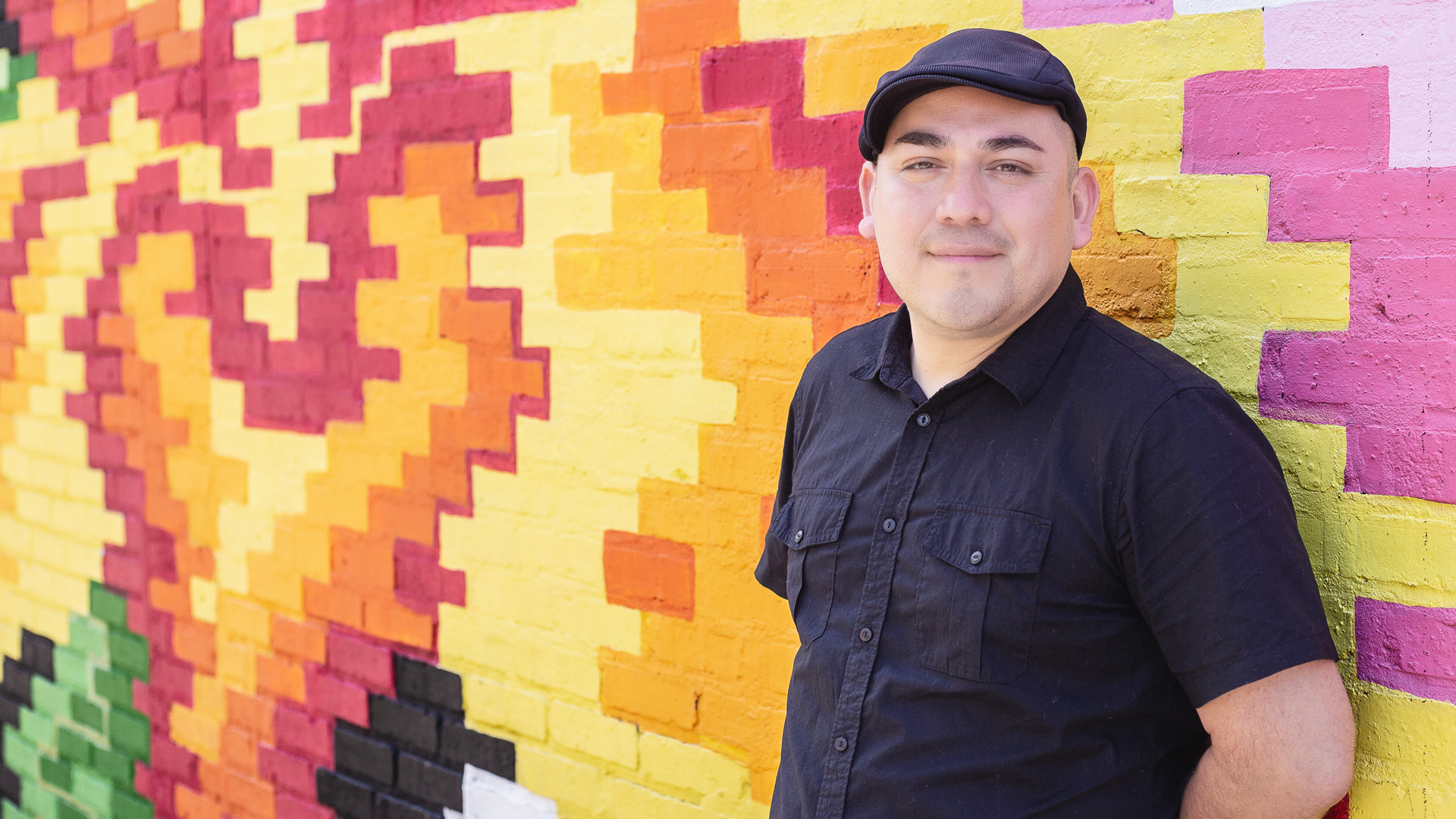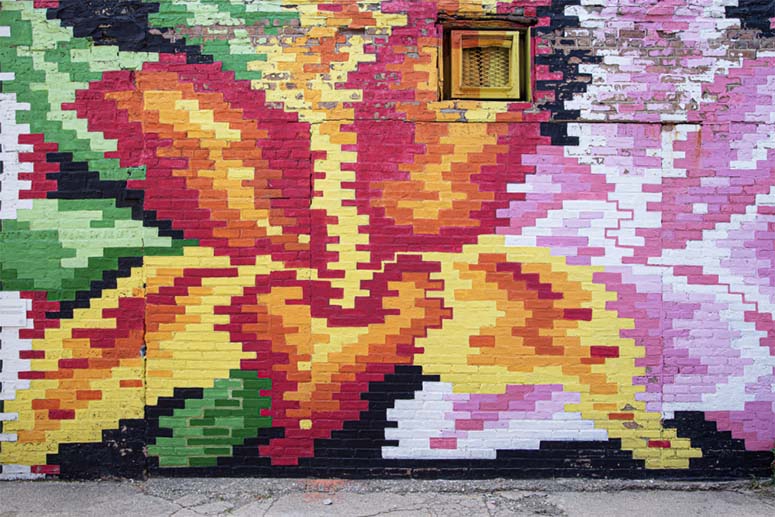
Photo By: Scott Benbrook
Finding the Concept
There have been numerous instances in Juan De La Mora’s life where he felt torn between two worlds. Take his career, for instance.
Then there’s his heritage. As a muralist, De La Mora has left his mark all across the Chicago metro area—but also in Mexico, where his parents are from.
“Chicagoans look at you as Mexican. Mexicans look at you as American,” he says. Of his murals, he adds, “It’s like Mexican food in America: It’s not the same, but you put a twist in.”
He’s painted roughly 50 murals in all, receiving local media attention in addition to plenty of Instagram and Pinterest attention. Tourists and influencers sometimes pick his works to pose in front of. As for his architectural models, he’s been more of a conceptual designer than a frontman.
“Juan is one of my favorite current artists based in Chicago from Mexico. With his career, being Mexican, I kind of understand this notion of being in the shadows sometimes,” says Rafael Robles, the co-founder of architectural design firm Duo Development.
“When I think of Juan and his work, I think of two very distinct things. On the one hand, there’s the architecture, and on the other hand there’s the murals,” says client Lou Bank, founder of Sacred, a Chicago-based nonprofit that supports Mexican communities that distribute heritage agave spirits.
“They seem like two very disparate forms of art, but I feel like what he’s trying to do is tell a story with each of them.”
A UNIQUE EDUCATION
De La Mora really started mixing art and architecture after moving to Portugal. It was the second time he’d left architecture school.
“My community of artists look at me as an architect. And the community of architects look at me as an artist,”
—Juan De La Mora
The first time was from Illinois Institute of Technology, after extending a trip abroad to Madrid in 2000. He decided to stay in Spain for what eventually turned out to be five years because, “I felt the poetry of architecture there. People don’t talk about it that way here. You’re maintaining a tradition, a legacy in Spain.”
But while going to school part-time at Escuela Técnica Superior de Arquitectura de Madrid, he also started two side gigs that conform to his dichotomous interests: an architectural model business and street art.
For his street art, he focused on a national celebrity: the white albino gorilla, Snowflake—the only one of its kind in captivity. De La Mora felt an affinity within the gorilla’s eyes and expressions.
“You can relate to some of the things about him. Feeling different, trying to fit in,” De La Mora says.
His work was notable enough to attract some esoteric patrons, including a pair of gallerists who told him about a tiny town in Portugal: Montemor-o-Velho.
A rural town of about 800 people, Montemor-o-Velho was built around a medieval castle on a hill; the galerists had an acquaintance who owned multiple properties there. De La Mora could go there and paint, as well as create sculptures and larger constructs of wood, copper, and construction materials among the town’s patios, courtyards, and gardens. An abundance of art and architecture.
So that’s what De La Mora did, taking an eight-hour bus ride to Portugal monthly, then back to Madrid to earn enough to keep his art going. His first commission, Torre Azul, was a multi-story, sky-blue, wooden watchtower constructed near the base of the castle. Schooling drifted by the wayside.
Artists always told De La Mora they could sense his architectural background—its structure and discipline. He even considered going to a third architecture school in Coimbra, Portugal. But when he went to visit the dean, she offered him some blunt advice.
“It would be a waste. Go back to Chicago or Madrid,” she told him. If it was an education he wanted, go big.

MAKING A MARK
After seven years abroad, De La Mora returned to Illinois Tech and rediscovered why he’d enrolled in the first place.
“I grew up as such a shy kid. Architecture school made me realize that’s there’s more people like me. If you come into a place where people recognize you, your confidence grows,” he says.
Born and raised in the southwest Chicago neighborhood of Chicago Lawn by first-generation Mexican immigrants, De La Mora suffered from Kawasaki disease as a child, a pulmonary condition that made his heart behave like a 65-year-old’s. So, he “drew every day. Robots, buildings, trucks, airplanes. Pretty much my dad’s hobbies. From my dad, I knew I wanted to be an architect.”
His father, a Chicago mechanic who built model airplanes to show off at competitions, started having De La Mora work in his mechanics shop at the age of 8. The money, invested early in the stock market, helped support De La Mora in Spain.
After finishing his degree from Illinois Tech in three semesters, De La Mora began working at Studio Gang, where he directed the architectural firm’s model shop. There, he helped design thousands of models for more than a decade while creating murals on the side.
“Murals were my meditation, my pull away from architecture, when I don’t have to be in design team meetings. Just myself,” De La Mora says. Still, when painting them, he makes a point to talk with anyone who stops to watch. And he didn’t worry about graffiti being painted over his art.
“The rule on the street is if you paint a mural, you respect it. I never put earbuds in. I want people to approach me,” he says. It’s important to include as much community input as possible: “Otherwise, why do it?” he asks.
Bank notes that De La Mora went out of his way to research several murals about the traditional agave distillation process. He traveled to rural Mexico, where he learned about the process himself, cooking plants in underground, stone-lined ovens.
“He wanted to see the authentic part of it. That’s how he is,” Bank says. One mural now rests on the outer walls of CH Distillery in Chicago’s Pilsen neighborhood, another on the side of a liquor store in the Little Village neighborhood. De La Mora painted the third on the garage door of his own home in Chicago’s Pilsen neighborhood.
More recently, De La Mora attracted media attention for painting a 90-foot-long pedestrian tunnel in Glen Ellyn, Illinois, a Chicago suburb. His design, contracted by the College of DuPage in 2022, was picked via an online vote that included more than 60 other proposals.
True to his philosophy, De La Mora tied the project to its hometown. He created a mural of winding branches and leaves—an homage to local trees drifting through their seasonal changes—after researching that the town was associated with trees and once stood in a heavily forested area.
As for architecture, when the COVID-19 pandemic hit, De La Mora decided to leave Studio Gang. “I wanted to look for and create my own design problems to solve,” he says.
He’s started his own art and architecture practice, JDLM Designs, to try to “capture the human side of architecture.”
Notes Duo Development founder Robles, who once worked with De La Mora at Studio Gang and considered him a mentor, “He doesn’t just do murals, just do models. I would describe Juan as more of a conceptual artist. With model making, he’s really good at pushing the concepts of a project forward.”
Adds De La Mora, “The hardest part in architecture is to maintain your concept. Once the concept gets diluted, it’s like, what am I doing this for?”